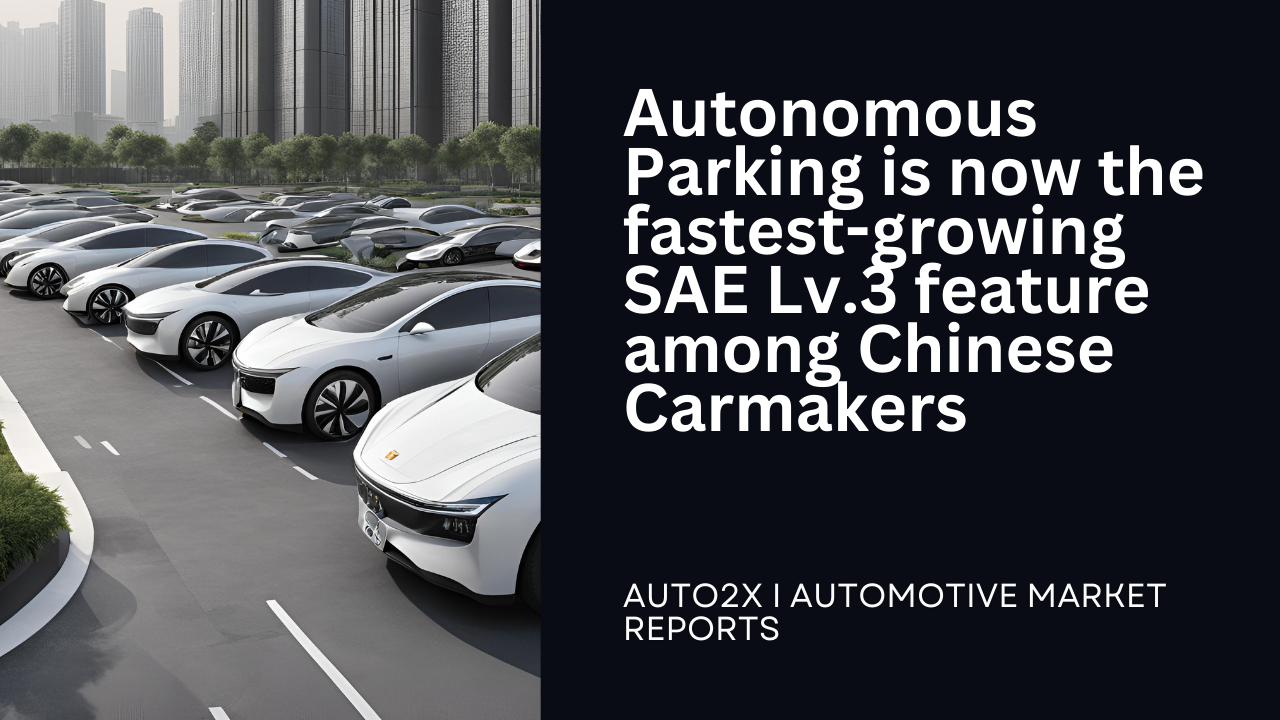What is Autonomous Parking?
Autonomous Parking features, in which vehicles automatically get to the parking space in the garage, have already been commercialized in China, the world’s leading car market.
Automated parking is a significant innovation that generates added value through improved efficiency in parking. With automated parking, the parking process in shared parking areas can be carried out more quickly and safely and the parking capacities are better utilized.
“Autonomous parking systems have currently became the fastest growing Lv.3 feature for Chinese Carmakers“
Auto2x
Advances in-vehicle connectivity, IoT applications and smart infrastructure can enhance the deployment of autonomous parking technologies. At the same time, China’s commitment to Intelligent & Connected Vehicles could fast track regulatory changes to give a head start to domestic brands. Finally, the advanced digital infrastructure and the burgeoning mobility market hold the potential to boost the adoption of AMoD.
China is planning to realize the scale production of vehicles capable of conditional autonomous driving and commercialization of highly autonomous vehicles in certain circumstances by 2025, according to a blueprint issued in Dec.2020 by the National Development and Reform Commission, the Ministry of Industry and Information Technology and nine other ministries.
The penetration rate of Lv.2 and Lv.3 intelligent networked vehicles continues to increase; it is expected to reach 50% in 2025 and exceed 70% in 2030
Chinese Society of Automotive Engineers (2020)
According to the IoV Industrial Development Action Plan issued by the public authorities in late 2018; conditional autonomous Lv.2 driving assistant systems and in-vehicle connected information service terminals should be installed by 2020 into more than 30% and 60% of new cars respectively.
At present, Chinese Carmakers adopt a mixed model of AD development, that combines conditional autonomous driving technologies (i.e. Lv.2) and robust in-vehicle connected infotainment products; with higher levels of autonomy (i.e. Lv.4) concentrating only in smart-mobility segments; i.e. robotaxis, ride-hailing services, public transportation sector etc.
Achieving true fully automated driving is a long-term business procedure; deploying autonomous parking technology is a good starting point
Smart parking infrastructure in its entirety (i.e. sensors, communications networks etc.) can be leveraged to help enable cars of the future to park themselves. AV fleets are also expected to fundamentally change the way cars are used, affecting how often and where future vehicles will be parked.
Autonomous parking technology, as a low-speed and complex scene of the “last 100 meters” of autonomous driving, can help accumulate abundant training data and facilitate the technological evolution of next-generation autonomous & intelligent networked vehicles.
At present, several Chinese Carmakers, including BYD, Changan, Great Wall, Geely, and SAIC have already introduced Self-Parking capabilities that rival the likes of Audi, BMW, Mercedes-Benz and Tesla.
Chinese carmakers leverage their strategic partnerships with foreign OEMs and domestic tech pioneers to mass-deploy their autonomous parking capabilities. ORA’s full-scene Automatic Parking system, BYD’s Vision Fusion Automatic Parking, Geely’s FOTA and 5G Autonomous Valet Parking, Changan’s APA 5.0 Remote Control Valet Parking; all provide point-to-point memory parking by integrating visual SLAM and ultrasonic radars to memorize and learn commonly used parking spaces and driving routes.
Recently, FAW Hongqi and Xpeng have launched their first full-featured software valet parking systems, that support commercial parking lots and private parking spaces. In both systems, the vehicle can drive unmanned in the parking lot, automatically find a parking space and drive out from the parking space to the location designated by the user. The system can also memorize the user’s parking route.
Case Study: Changan CS75 Plus is equipped with APA 5.0 remote control valet parking system.
APA 5.0 parking system integrates 4 HD wide-angle cameras (360° view) and front/rear parking radars to enable the vehicle to realize horizontal parking, vertical and diagonal parking, find a parking space within 20m, enter the parking space and complete the parking process automatically. The car owner can also use the mobile phone APP to carry out one-key remote parking. The system integrates ultrasonic radar and high-definition camera data to identify parking spaces, vehicles, pedestrians, obstacles, etc., and has an emergency braking function.
Examples of SAE Lv.2 Parking Systems provided by various Chinese Carmakers
| Carmaker | Parking System | Models |
| BAIC Arcfox | APA one-key full-scene parking | a-T, a-S |
| Chery | FAPA + Remote Control Parking | Tiggo 8, EQ Big Ant |
| GAC | Bosch APA full-scene parking | Trumpchi Series: GS8, GA6 |
| Aion | FAPA Smart + Remote Parking | Aion Series: S, V , LX |
| SAIC Maxus | APA + Remote Control Parking | G20, G50, G50 Plus, D60 |
| SAIC Roewe | APA automatic parking | RX5 eMax, iMax 8 |
To learn more about competition and market developments in the next decade read our reports.

